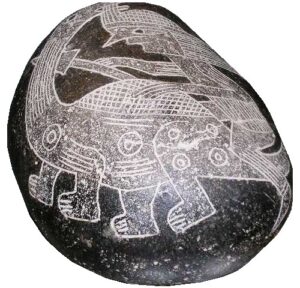Sep
22
Does Ancient Art Prove Humans Co-Existed with Dinosaurs?

One of the “evidences” for a young Earth that some Young Earth Creationists (YEC) like to present these days is the existence of paintings and carvings on stones (and maybe cave walls) that look a lot — or even just somewhat — like dinosaurs. (Or, at least, how dinosaurs are portrayed by modern artists. That’s another whole topic….) After all, such artwork requires human artists to render the paintings/carvings, which means that dinosaurs were around for humans to see first-hand. Therefore, dinosaurs lived within the past few thousands of years (i.e., when YECs believed sufficiently artistic humans existed), which fits more with YEC teaching than with “evolutionary” theory.
Setting aside the many evidences for a truly ancient Earth (and dinosaurs), is the above really plausible? What other, reasonable explanations for the existence of the art on these artifacts might there be? In a recent Facebook post, biochemist/apologist Fuz Rana of the Old Earth Creationist (OEC) organization Reasons to Believe (RTB) addressed this issue and gave three explanations, which he graciously allowed me to replicate below.
— — —
Did humans live with dinosaurs?
YECs claim that we did.
One line of evidence that YECs advance to support their claim is ancient art that depicts humans alongside dinosaurs.
I am often asked: How do I explain these finds, as an Old Earth Creationist, if humans and dinosaurs didn’t co-exist. There are three explanations:
1) These pieces are forgeries. This appears to be the case for the figurines found in Acambaro, Mexico. In support of this claim, the surfaces of these figurines don’t display any signs of age. No dirt is packed into their crevices, and though some figurines are broken, no pieces are missing, and no broken surfaces are worn. Most importantly, the excavation’s stratigraphy clearly showed that the artifacts were placed in a recently dug hole filled with a mixture of the surrounding archaeological layers.

It also appears to be the case for the Ica stones found in Peru. The artists style of these figurines doesn’t match the style of other artifacts recovered from the region. There is evidence that the carvings in these stones was made through oxidized materials on the rocks surface. And, finally, the people selling them admitted that they were forgeries made to sell to tourists.
2) The art coincidentally looks like dinosaurs. In some cases, the art reflects mythical creatures. Other instances, the art reflect exaggerated features of existing creatures that makes the art appear like dinosaurs. For example, “pterosaur” painting in Black Dragon Canyon, Utah, is not a single painting. Its “head” and “neck” are a painting of a person with outstretched arms. Its torso and limbs are those of a painting of a second person with outstretched arms, whose body continues into the “pterosaur’s” “wing.” The other “wing” is a painting of a horned serpent. A “dinosaur” petroglyph in Havasupai Canyon, Arizona, is a stylized bird with an extension on one foot with a stylized bird head. A “dinosaur” cave painting in Tanzania is an obvious giraffe. Cave paintings of long-necked dinosaurs in Zambia have short necks and most likely represent lizards.
3) The art reflects reconstructions of dinosaurs based on the recovery of dinosaur footprints and skeletal remains. This appears to be the case for the drawings made by Bushmen in Africa. These cave paintings show dinosaurs reconstructed from footprints; trackways and skeletal remains have been found in Lesotho. This is a region of prolific dinosaur trackways preserved in Lower Jurassic sedimentary rocks. Bushman artists anticipated modern reconstructions of bipedal dinosaurs and produced depictions that are more realistic than many paleontological reconstructions that endured until quite recently.
— — —
I think Dr. Rana proposes very plausible, even probable, explanations for the bulk of such “ancient dinosaur art”. (I suppose there could be others along similar lines, as well.) Unfortunately, some die-hard YECs challenged him on his FB thread with comments demonstrating a mix of ignorance (both scientific and scriptural), arrogance, poor reasoning skills, and loads of unwarranted speculation. Rana was very gracious nonetheless.















